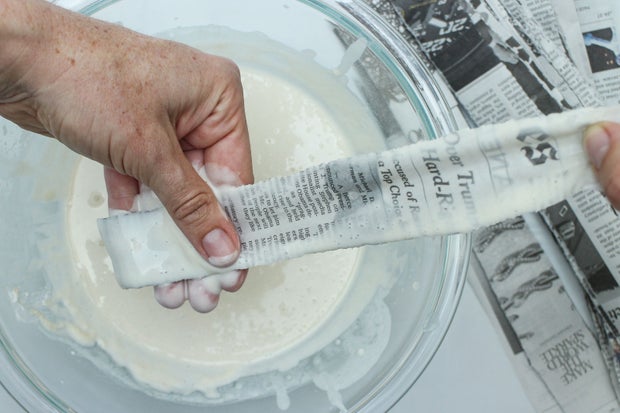Introduction: Tools and Materials for Paper Mache
While paper mache can mostly be made with materials you already have around the house, getting a few specific supplies will really take your sculpting game to the next level. Here's what I'll be using in this class:
Tools:
- Scissors
- Mixing bowls
- Measuring cups and spoons
- Airtight container or ziplock bag
- Craft knife and extra blades
- Sand paper
- Palette knife or butter knife
- Paint brushes
- Cloth tape measure
- Pencil and paper
- Plastic wrap
- Drop cloth or other plastic cover
- Ruler
Materials:
- Newspaper, newsprint or blue shop towels
- Floral tissue paper, kite paper or rice paper
- Crepe paper
- Cheap toilet paper
- All purpose white flour
- GlueAll, wood glue, wallpaper paste or ModPodge
- Joint compound
- Glycerin or linseed oil
- Balloons
- Masking tape
- Wire sculpting mesh
- Cardboard
- Found objects for creating armatures
- Acrylic paint
- Gesso or Flexbond or another sandable smoothing compound
Optional Tools and Materials:
- Immersion blender
- Hand mixer
- Glue gun
- Store bought CelluClay or Creative Paperclay
- Oil of cloves or cinnamon
- Spray paint
- Sculpting tools
Step 1: Possibilities of Paper Mache
While most of us probably think of paper mache as an unsophisticated craft technique used to make piggy banks in 3rd grade classrooms, it is actually an extremely useful and versatile medium that can be used to create some beautiful works of art, costume pieces, or even home decor.
One of the best things about paper mache is that it is cheap, and doesn't require any fancy equipment or special skills. It's also extremely versatile and forgiving. You can use paper mache to create anything from delicate lamps to huge whale sculptures! Feel free to check out my Paper Mache Pinterest board for some inspiration.
If creating projects with paper mache sounds intimidating to you, remember, you can almost always cut your paper mache creations apart and stick them back together, so altering your designs or adding details as you go is simple!
Step 2: Types of Paste and Paper
The basic formula for paper mache just involves saturating some kind of paper with some kind of sticky paste, sculpting with this material and then letting it dry. Paper mache paste is mostly created with glue, flour and water in various combinations.
Different kinds of paper and paste are good for different kinds of projects. Flour and water is the classic material for paper mache paste because it is super simple, effective and cheap. Glue paste tends to be stronger and more durable, and it also dries clear so it it is great to use if you want to create something translucent like a lamp. It can also be a bit slippery and sticky though, so some people prefer flour.


Newspaper is the most commonly used paper for paper mache because of its consistency and because old newspaper is basically a free material. Other papers will work too though. Some people like to use blue shop towels because they are very soft and absorbent, but also strong.


Translucent papers like waxed tissue paper and kite paper are great if you are using glue and trying to create a skin that lets light through.


In this class we'll try a few different kinds of paper and paste so you can see the advantages and drawbacks of each.

The name Paper Mache is an english version of the French "Papier-mâché" which literally translates as "chewed paper". This original definition of paper mache actually refers to paper mache clay, which is a sculpting material made of mashed or "chewed" paper and a few other ingredients. You can use this clay to create details, sculpt forms, or even press it into molds. We will talk about using pre-made versions of this clay and also learn how to make our own using a highly underrated art material: toilet paper!


Step 3: What You Can Make!
The Techniques you learn in this class can be applied to a lot of different projects, from simple to complex. Along the way I'll be pointing you towards some projects that would be great ways to practice your skills, like these DIY Owl Piñata, Easy Paper Mache Mask, and Paper Mache Lampshade Instructables I've written.
Step 4: Quiz
{
"id": "quiz-1",
"question": "Which kind of paper is not good for paper mache?",
"answers": [
{
"title": "Glossy magazine paper",
"correct": true
},
{
"title": "Newsprint",
"correct": false
},
{
"title": "Floral tissue paper",
"correct": false
}
],
"correctNotice": "That's right, glossy magazine paper does not absorb water well enough to be good for paper mache.",
"incorrectNotice": "Not quite, try again"
}
{
"id": "quiz-2",
"question": "The tools and and materials you need for paper mache are really expensive.",
"answers": [
{
"title": "false",
"correct": true
},
{
"title": "true",
"correct": false
}
],
"correctNotice": "You're right! Paper Mache is really a very inexpensive hobby!",
"incorrectNotice": "Not quite, try again"
}
{
"id": "quiz-3",
"question": "An armature is:",
"answers": [
{
"title": "A vehicle used to transport soldiers",
"correct": false
},
{
"title": "A base structure that you paper mache over",
"correct": true
},
{
"title": "A weird animal from Australia",
"correct": false
}
],
"correctNotice": "Yes!",
"incorrectNotice": "Are you sure? Try again!"
}
Step 5: What's Next?

Now that you know what you will need for this class, gather your supplies and let's get messy! In the next lesson we'll learn how to make an easy glue and water paste and use it with different kinds of paper!













